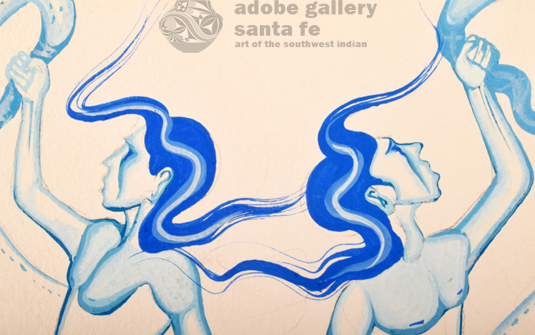Original Navajo Painting of Blue Fire Dancers by Beatien Yazz [SOLD]
+ Add to my watchlist Forward to Friend
- Category: Paintings
- Origin: Diné of the Navajo Nation
- Medium: Watercolor
- Size:
9-½” x 8” image;
15-½” x 13-5/8” framed - Item # C4209B SOLD
Beatien Yazz was a self-taught artist from the Navajo Nation. Alongside his classmates at the Santa Fe Indian School, he contributed to the proliferation of a painting style that is highly sought after by collectors. This sweet painting takes a very specific subject and presents it in an approachable, attractive fashion. Here, we see two Diné Fire Dancers.
In the late 1800s, Dr. Washington Matthews observed the Diné and published information on the tribe, its ceremonies and crafts. In 1909, Oscar H. Lipps published a book entitled A Little History of The Navajos in which he quoted Dr. Matthews’ description of the Navajo Fire Dance, which he called “The Fire Play.” The following description of ‘The Fire Play’ is taken from Dr. Washington Matthews original writing as reproduced by Oscar Lipps.
“The eleventh dance was the fire dance, or fire play, which was the most picturesque and startling of all. Every man except the leader bore a long, thick bundle of shredded cedar bark in each hand and one had two extra bundles on his shoulders for the later use of the leader. The latter carried four small fagots of the same material in his hands. Four times they all danced around the fire, waving their bundles of bark toward it. They halted in the east; the leader advanced towards the central fire, lighted one of his fagots, and trumpeting loudly threw it to the east over the fence of the corral. He performed a similar act at the south, at the west, and at the north; but before the northern brand was thrown he lighted with it the bark bundles of his comrades. As each brand disappeared over the fence some of the spectators blew into their hands and made a motion as if tossing some substance into the departing flame. When the fascicles were all lighted the whole band began a wild race around the fire. At first they kept close together and spat upon one another some substance of supposed medicinal virtue. Soon they scattered and ran apparently without concert, the rapid racing causing the brands to throw out long brilliant streamers of flames over the hands and arms of the dancers. Then they proceeded to apply the brands to their own nude bodies and to the bodies of their comrades in front of them, no man ever once turning around; at times the dancer struck his victim vigorous blows with his flaming wand; again he seized the flame as if it were a sponge, and, keeping close to the one pursued, rubbed the back of the latter for several moments, as if he were bathing him. In the meantime the sufferer would perhaps catch up with some one in front of him and in turn bathe him in flame. At times when a dancer found no one in front of him he proceeded to sponge his own back, and might keep this up while making two or three circuits around the fire or until he caught up with someone else. At each application of the blaze the loud trumpeting was heard, and it often seemed as if a great flock of cranes was winging its way over head southward through the darkness. If a brand became extinguished it was lighted again in the central fire; but when it was so far consumed as to be no longer held conveniently in the hand, the dancer dropped it and rushed, trumpeting, out of the corral. Thus, one by one, they all departed. When they were gone many of the spectators came forward, picked up some of the fallen fragments of cedar bark, lighted them and bathed their hands in the flames as a charm against the evil effects of fire.” From the book: A Little History of the Navajos by Oscar H. Lipps
Here, Beatien Yazz (1928-2012) Little No Shirt - Jimmy Toddy presents his Fire Dancers in a wash of blue, reinforcing to the viewer that this dance occurs during the night. Outlining and shading his figures with blue—rather than surrounding them with a solid blue sky—was a creative compositional choice. His dancers are made of just two colors: a light blue and a darker blue. A few small accents of white are visible, but only just so. They nearly match the paper’s soft off-white color. Yazz’s work here is precise but fluid, all shadow and shading, with dark blue outlines that are reinforced by wider lines of light blue. His subjects face away from each other, each holding one “flaming wand” up and the other at his side. The flames they carry are represented by wispy, curving trails of blue dots and lines. This excellent painting presents an imaginative vision of a classic Diné image.
 The painting is signed B. Yazz in lower right. It is framed beautifully in a simple black frame with a blue mat.
The painting is signed B. Yazz in lower right. It is framed beautifully in a simple black frame with a blue mat.
Condition: this Original Navajo Painting of Blue Fire Dancers by Beatien Yazz is in excellent condition
Provenance: from the estate of Frances Balcomb through a daughter
Recommended Reading: A Little History of the Navajos by Oscar H. Lipps
Relative Links: Beatien Yazz, Native American Paintings, Navajo Nation

- Category: Paintings
- Origin: Diné of the Navajo Nation
- Medium: Watercolor
- Size:
9-½” x 8” image;
15-½” x 13-5/8” framed - Item # C4209B SOLD



